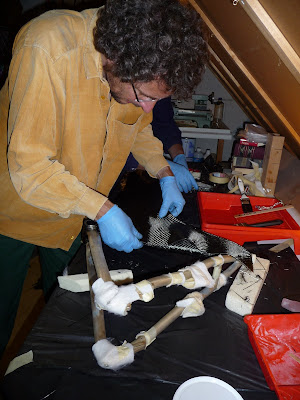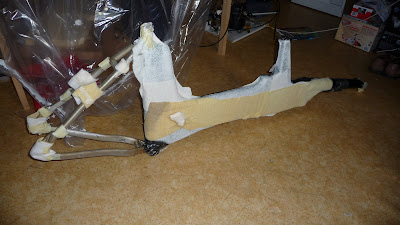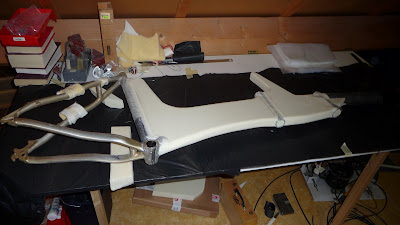We have been moving houses, so the limited time had to be divided between the house, the family, the bike and the Blog, and the Blog lost.
Now a short update with some photo's.
I managed to get the bike ready. I turned and milled the last parts for the steering and for the stoker freewheel.
For that last part I use a BMX freewheel screwed onto an old threaded hub. I completely modified the hub with a new single ball bearing and bolted a 22 tooth chainwheel onto the flange. Not perfect, but it works. I wanted to make the entire setup myself, but I ran into the problem that my lathe does not have proper gearing to make the 24tpi thread required for the BMX freewheel. I use an excenter to tighten the middle chain. To tighten the front chain I move the boom.
The handlebars have been another problem. I bought triathlon handlebars, and after mounting them I discovered that they had a diameter slightly larger than the standard 22.4 mm. So mounting the Magura HS33 brakes and the Rohloff gripshifter proved impossible. I the end I found a solution in the purchase of the handlebars for a so called "motherbike" (moederfiets). These are deep and wide. I bend them more narrow, and mounted them reversed. Together with Cane Creek ergocontrol bar ends (not yet on the photographs) it is a quite nice handlebar setup . It even allows my wife Edith, who is quite a lot smaller than I am, to ride the bike.
The bike is now christened "Santiago". The city of Santiago is paramount for travel and pelgrimmage by human power and it contains part of the name Santos, the bike builder who supplied the rear of the bike.
Ok, now some images:
Santiago in the workshop, still without saddle. The upper part of the front seat has been removed by now. The front seat is a modified old wooden M5 recumbent seat. You can see the stoker freewheel below the seat.

Just out of the workshop for the first time.

Santiago with me and Yentl (my eldest daughter).



 Levia, the youngest, insists on a test drive as well. She is still to small, and I have to shorten the boom and use shorter cranks to enable her to really use the bike. Here I just hope she won't fall off.....
Levia, the youngest, insists on a test drive as well. She is still to small, and I have to shorten the boom and use shorter cranks to enable her to really use the bike. Here I just hope she won't fall off.....

 And a short video, regretfully on its side until I have time to change this.....
And a short video, regretfully on its side until I have time to change this.....







































